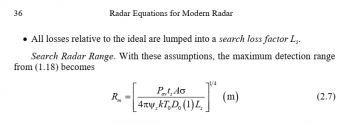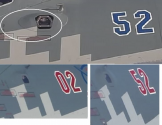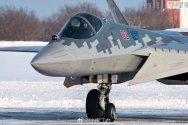Some people talk as if the smaller amount of TRM modules on the N036 radar on the Su-57 is some sort of manufacturing issue Russian industry has. It was a deliberate design choice. If you include the side radars on the Su-57 it uses more TRM modules total than the F-35 with its single fixed position radar.
You are using an out of date browser. It may not display this or other websites correctly.
You should upgrade or use an alternative browser.
You should upgrade or use an alternative browser.
Russian Su-57 Aircraft Thread (PAK-FA and IAF FGFA)
- Thread starter A Bar Brother
- Start date
There are more important things than the no of TRM module in the radar. The exact specifications of the power amplifiers, mmic and hemt along with the asic and FPGA matter more.Some people talk as if the smaller amount of TRM modules on the N036 radar on the Su-57 is some sort of manufacturing issue Russian industry has. It was a deliberate design choice. If you include the side radars on the Su-57 it uses more TRM modules than the F-35.
Yes, I agree. That is my point as well : )Are you seriously know what you are talking about ? I am not even talking about Beamwidth here. My point is that there are MANY options other than increasing module counts if one desire increased range.
The force carrier of electromagnetic field is the photon .Are you talking about Radar or Infra red device ? Again, use radar range equation.
What i am using in my calculation is GAIN.. which is related to ANTENNA AREA or It's effective area. That is why you see "^2" or Square in my calculations.
If one antenna have 30% bigger AREA than the other the gain would be in factor of 1.69 or 69% But the range is then only a factor of 1.14 or 14%. That is the 4th Root law of Radar propagation.
The radar and the IR device registering the same radiation, but on different wavelength.
"^2" or Square means you use diameter in the calculation, not area.
I correct myself - the calculation that I mentioned would be true only for bistatic radar, with monostatic radar use the same antenna for radiation and reception.
I spent time long time ago with light/camera systems : )
Means the antenna area has to be squared, and after 4th root, so in reality the area and the range has a square root relationship.
Means double the area will increase 41% the range.
so, in the F-35 vs Su-35 case the F-35 needs 2.4 times bigger power to have the same range, if everything else is the same. 1 m vs 0.8 m diameter .
"^2" or Square means you use diameter in the calculation, not area.
Square here is GAIN. Monostatic Radar use same antenna for reception and transmission thus the gain is squared. and Gain relates to the antenna effective antenna area. You can review basic radar range equation in any radar textbook and you will find this :

Gt and Gr is the Gain of the antenna respectively in Receive or in Transmit. If the radar use the same antenna for receiving and transmitting then one can have G^2.
Means the antenna area has to be squared, and after 4th root, so in reality the area and the range has a square root relationship.
You square the GAIN not the area. if you are using Antenna area. it is not squared. You can review the search radar equation.

The area are NOT squared. Thus if you are using 4th root law then doubling the area means the range factor would be :
(2)^(1/4) = 1.18 or 18% increase in range. Not 41 %.
Yes, I agree. That is my point as well : )
But increasing module counts does not decrease wavelength. Your point are unfortunately confusing and unclear to say the least.
The radar equation is a composition of the equation , that is combined in the case of monostatic radar, the first one is the illumination ,tht is a calculation of energy/area on the distance between the emitter and the illuminated cross section, and the back radiated energy from it .Square here is GAIN. Monostatic Radar use same antenna for reception and transmission thus the gain is squared. and Gain relates to the antenna effective antenna area. You can review basic radar range equation in any radar textbook and you will find this :
View attachment 81756
Gt and Gr is the Gain of the antenna respectively in Receive or in Transmit. If the radar use the same antenna for receiving and transmitting then one can have G^2.
You square the GAIN not the area. if you are using Antenna area. it is not squared. You can review the search radar equation.
View attachment 81755
The area are NOT squared. Thus if you are using 4th root law then doubling the area means the range factor would be :
(2)^(1/4) = 1.18 or 18% increase in range. Not 41 %.
But increasing module counts does not decrease wavelength. Your point are unfortunately confusing and unclear to say the least.
The antenna size (and the number of radiation elements) narrowing the beam and increase the energy concentrated onto the surface of the target.
Now, on oposite trip the increase number of beam forming elements and radar size increase the sensitivity of the radar.
Means compared to the increase in the power , with decreasing density by square root outbound and inbound as well, the increase in size and number of elements has a energy density decrease by square root for the whole trip, beacuse the increase of these parameters affecting the inbound and outbound path. Compared to the increase in radiation power, that affect only the outbound path.
If you check the above equation the square(G) comtainn as a proportional part the Area, means increase in the area has 4th_root(square(Area)) connection with the received energy of radar.
Prbolem is the increase of frequency pushing into the optical reflection zone the effect of the shaping of the target, and the Mie scattering of the edges carry less energy . Means a military radar is a fine ballance between the expected target shaping and the possible number of elements.
One of the prettiest plane in the world. Like a ballerina.
In Tolmachevo, two new Su-57s got on amateur photos
04.02.2022In Novosibirsk, at the Tolmachevo airport, passengers of regular aircraft and local spotters captured two new fifth-generation Su-57 fighters that made an intermediate landing on February 3, 2022 while en route to their bases in the European part of Russia.
How they told me at the Center for Analysis of Strategies and Technologies (CAST), the photographs show two new Su-57 fighters built in 2021 at the Komsomolsk-on-Amur Aviation Plant named after Yuri Gagarin with red tail numbers "02"and " 52".
The Su-57 aircraft with tail number "02 red" was not previously seen. This machine bears on board the emblem of the 929th State Flight Test Center named after V.P. Chkalov of the Ministry of Defense of the Russian Federation in Akhtubinsk, and, apparently, is intended for this unit. The first serial Su-57 fighter (T-50S-2 aircraft, serial number 51002) actually received at the end of January 2021 by the RF Ministry of Defense received tail number "01" (originally blue), and, according to known data, was also transferred to the 929th GLITS in Akhtubinsk.
The second Su-57 aircraft captured in Novosibirsk has tail number "52 red" and was previously seen in a KnAAZ promotional video, but with tail number "52" in blue. This aircraft in Novosibirsk carries registration number RF-81775 on its tail. Previously, this registration number was briefly used during a deployment to Syria in early 2018 on the last, tenth flight prototype of the PAK FA - the T-50-11 aircraft with tail number "511".
“It can be assumed that the new Su-57 with tail number “52 red” may enter the 4th Order of Lenin of the Red Banner Center for Military Testing and Training of Personnel of the VKS named after V.P. Chkalov of the Ministry of Defense of the Russian Federation at the Lipetsk airfield,” the experts of CAST believe.

Attentive observers testify that the new Su-57s with tail numbers "02 red" and "52 red", and the aircraft "52 blue" from the recent KnAAZ video, apparently seen in Novosibirsk, have three different sides. According to one of the assumptions, the tail number "52 blue" would be the former last prototype of the PAK FA - the T-50-11 aircraft, which previously flew with the tail number "511".
Last edited:
The front part of the cockpit glass seem to have some kind of separation between the front and side. We see a line on different pictures. Is it a difference in thickness or some kind of embedded ram grid at the front and not on the side ??



